Seeing War Through Borrowed Eyes
Author Marya Hornbacher pens an elegant, insightful analysis of Megan Rye's archive of complex, humane paintings documenting the Iraq war. (On view in the Burnet Art Gallery at the Chambers Hotel from November 14-January 11)
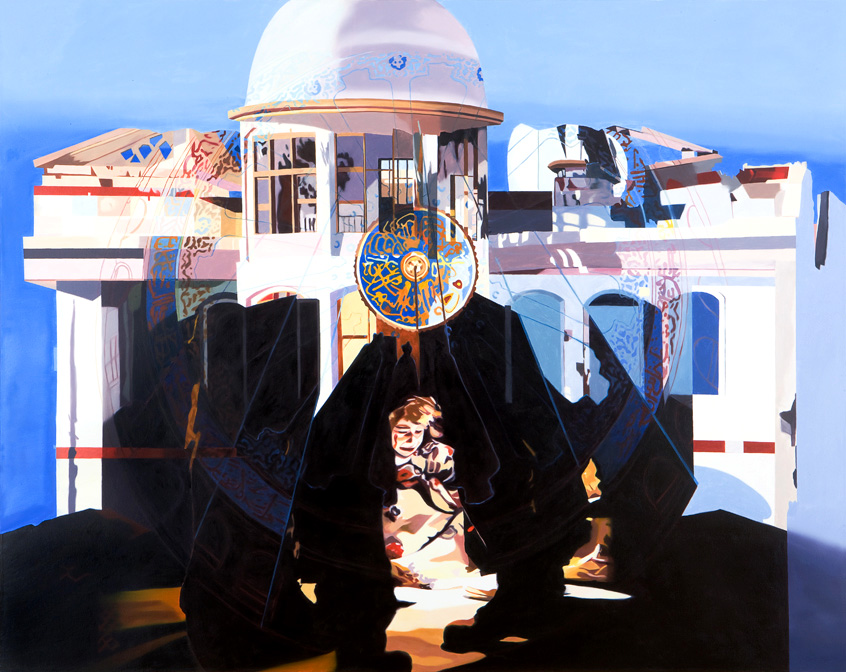
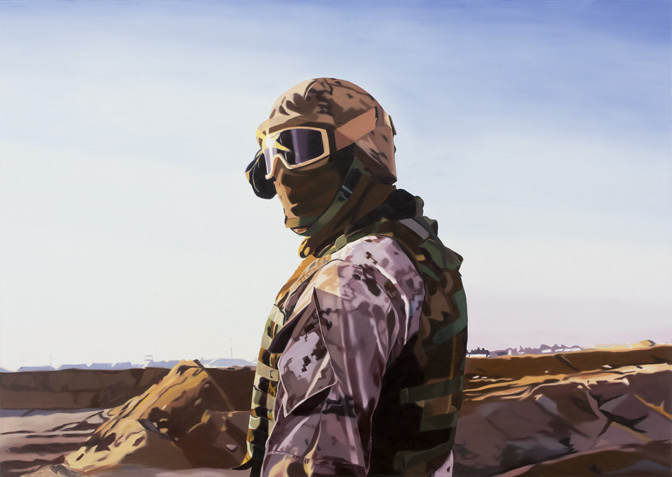
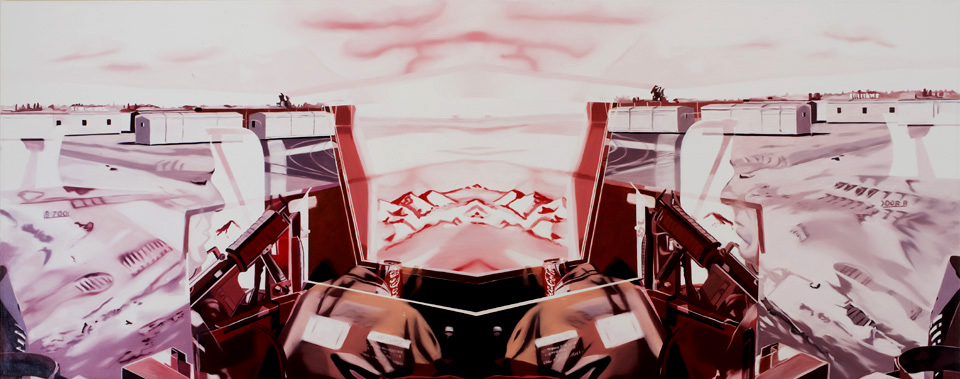
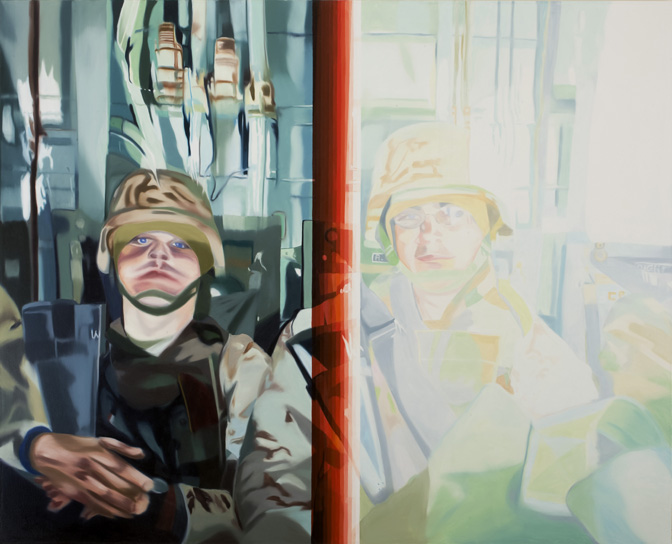

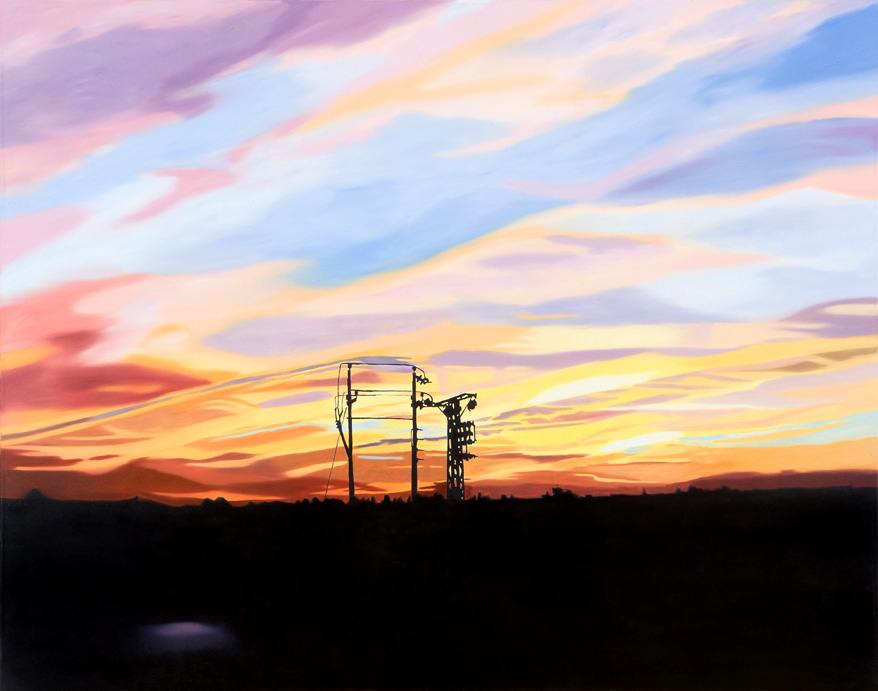
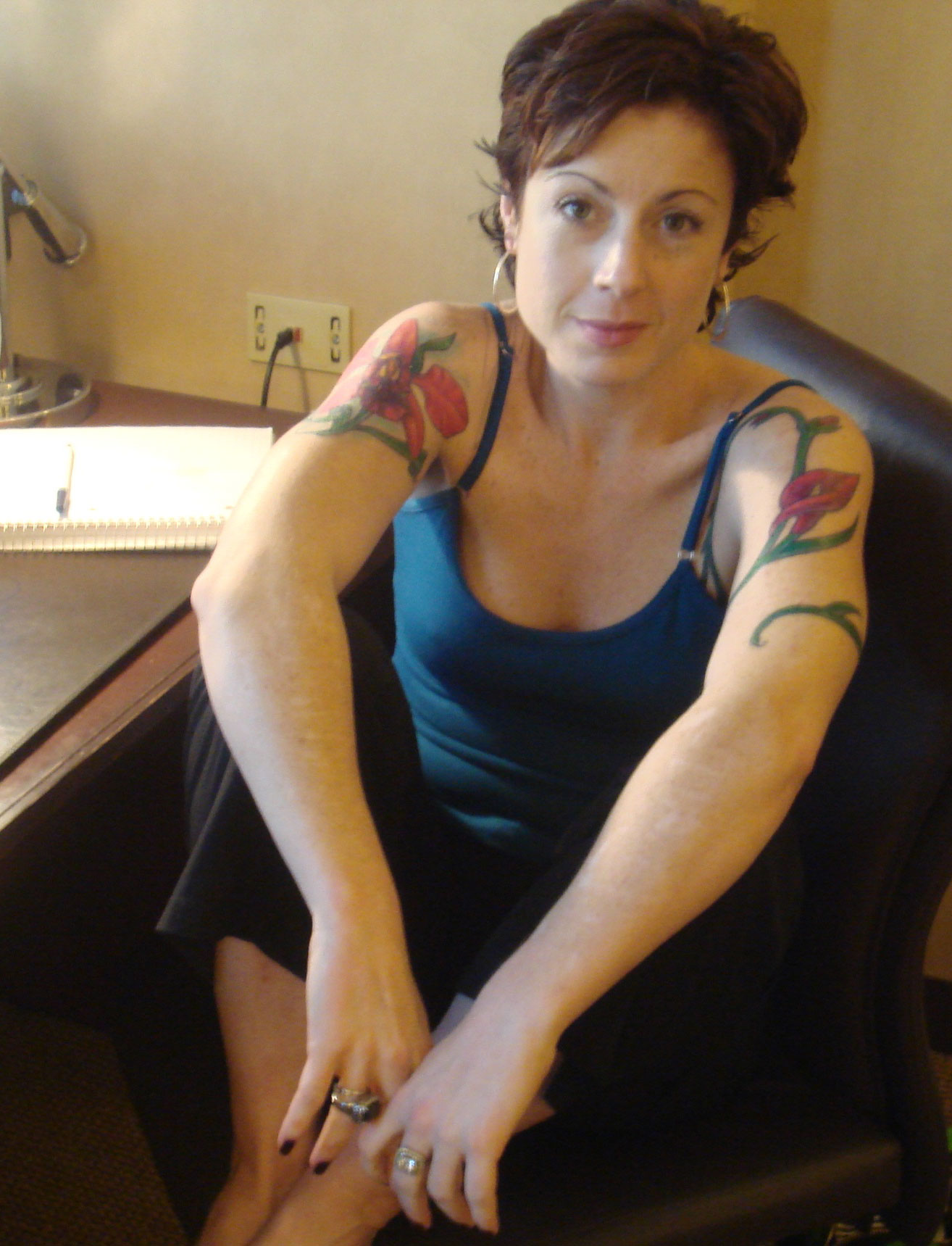
DECEMBER 21, 2004. 0800 HOURS. NEAR MOSUL, IRAQ. A suicide bomber walks into an American Army mess hall tent and detonates himself on Christmas Eve, killing at least 22 people, including 14 U.S. service members. A photographer captures the moment just after the explosion: an enormous hole torn in the tent’s roof, desert sun streaming in on the rubble of overturned tables and bodies and chairs.
The next morning, on a sunny winter day near Minneapolis, Megan Rye ambles into her kitchen and picks up the front section of the paper while she makes her chai. “I had just woken up, and I was kind of groggy. I saw this image, and I thought—this looks like heaven. It’s beautiful. And then I realized it was this horrible event. I just had to paint it.”
That initial painting set off what has become an enormous body of work painted over the course of four years—an intricate, almost obsessive examination of the Iraq war. Megan Rye’s paintings are unexpected and breathtaking. Often shockingly beautiful, they deny easy reading, refuse to make a singular statement, presenting instead a sharp, nearly photorealistic series of images so quietly powerful the viewer tends to tumble into them headfirst. Saturated with color, technically brilliant, portraying not the rote images of war one might expect—no dead bodies, screaming children, or gore—the paintings capture, instead, moments of silence. Her recent exhibit at the Minneapolis Institute of Arts included paintings of an explosive sunrise over a darkened field; an eerie, close-range view of a soldier’s helmet from behind; an upturned face seen through the surreal green of night goggles; the candy-colored, light-flooded chaos of a store that’s been bombed. At first glance, it’s hard to say why these images, far removed from the easy bluster of anti- or pro-war sentiment, have the impact of a kick in the gut; but they do. They capture the viewer on an inarticulate level, reaching into the mouth and snatching the words right off your tongue. Rye’s paintings make an enormous contribution to the conversation about the Iraq war—but the comment they offer is a taut, echoing silence.
“By its very nature the Iraq war is controversial, and yet her paintings have an almost serene, still-life quality. They draw attention to the war and its importance as an issue we need to be thinking about, without telling us what to think,” says art collector Ralph Burnet, owner of the Chambers Hotel and its Burnet Art Gallery, where Rye’s new show Long Night’s Journey Into Day, will open on November 14. “That deliberate ambiguity is mesmerizing, and it underscores her talent as an artist. She’s taken something that, by its very nature, is raw, ugly, and emotional, and turned it into something that is thoughtful and beautiful. It’s amazing.”
Rye’s brother Ryan—a Marine and, stateside, a sculptor—was near Mosul on the day of that previously-mentioned explosion. “The idea to paint this war would not have occurred to me had my brother not been over there,” she says. Her brother returned from his tour with over two thousand photographs marked by his uncanny skill and observation. Rye’s relationship with the photographs is intense. She crouches on the floor of her studio, surrounded by a spray of them, going through stack after stack in search of the image she wants, the one that will demand to be painted. “The photographs sometimes contain images that are quite spontaneous and lovely, while others contain moments that are horrific and disturbing,” she says. “The entire archive has drawn me in.”
_________________________________________________
Rye’s paintings, far removed from the easy bluster of anti- or pro-war sentiment, capture the viewer on an inarticulate level, reaching into the mouth and snatching the words right off your tongue.
_________________________________________________
The artist’s relationship to the photographs reflects the viewer’s relationship to the painting in a very important sense: she transcribes a sense of distance from her subject that echoes our sense of distance from the war. “My brother coming back with thousands of images has provided me with a lot of information. But, no matter how much information is absorbed, giving me the illusion of proximity, it’s always countered with this vast distance, because I will never know—no matter how much time I spend with the photographs, no matter how many articles I read about Iraq, no matter how many films or documentaries or interviews I see. I can’t know what happened over there, really.”
Neither can we. These paintings invite us into vivid, almost living moments in the Iraq war, but their powerful silence holds us at arm’s length, reminding us that we can never fully enter the experience, never fully understand, never know what happened over there. Not really.
“It wasn’t a need to comment or to make art that reflects my views,” Rye says of her decision to paint the war. “It arose, I think, much more organically, even instinctively. While I have, of course, feelings about this war, about this political situation, that’s not the place from which this work is coming. When I say I’m obsessed with the subject—I think sometimes we don’t know why that happens.”
Rye’s words remind me of Gerhard Richter’s comments on why one paints in the first place. Rye counts Richter among her primary influences, so his thinking here is particularly relevant: “One has to believe in what one is doing, one has to commit oneself inwardly, in order to do painting. Once obsessed, one ultimately carries it to the point of believing that one might change human beings through painting. But if one lacks this passionate commitment, there is nothing left to do. For basically painting is idiocy.”
Rye’s obsession with Iraq emerges from a more fundamental place than polemic or simple opinion, and the resulting work echoes those depths. Most of us come in contact with the war through the white noise of television, radio, newspaper, and magazine reports. Rye’s paintings confront the viewer and bring Iraq to life for us, and viewing them collectively is an extremely powerful experience, bringing us face to face with the war’s realities: with its people, its places, its moments of quiet horror and beauty alike. “When you go to an art gallery, it is a very specific place, a place of contemplation where all other distractions fall away. There is only you and the subject matter. I want to create that space where people can think about and come to terms with their own feelings about the war.”
_________________________________________________
Most of us come in contact with the war through the white noise of television, radio, newspaper, and magazine reports. Rye’s paintings confront the viewer and bring Iraq to life for us: with its people, its places, its moments of quiet horror and beauty alike.
_________________________________________________
And what we feel is a powerful sense of uncertainty. Of ambivalence. Of anxiety. Her work quietly invokes the absolute impotence so many of us feel about this war—powerless even to understand what it is, what it’s about, when it will end. The beauty of Rye’s paintings is part of what creates that sense of discomfort. We expect, in looking at art that represents war, to see ugliness and bald horror. That is an easy, familiar message to read. But, at their essence, these works point up the absence of such familiar signs of war around us. Looking at Rye’s paintings, we wait to see a war we can recognize and react to at a personal and visceral level, something clear and knowable to rally around or to resist. While Rye’s art is not intended to be overtly political, her paintings act on the viewer, moving those who see them in such a way that they feel a compulsion to act—and realize that they cannot. In Rye’s paintings, this shock of beauty, where we expect horror, crystallizes for the viewer a number of inchoate, even conflicting qualms about this war: a pervasive sense of helplessness, a fear of the uncertain, the ambiguous, the unknown. And these discomforts, once realized, can more intimately be known.
“That ambiguity, that sense of confusion and anxiety about not being told what to think, about not even knowing what to think sometimes—that is an important part of the work to me,” the artist says. “The fact that something that is sad and devastating can also be beautiful is unsettling.
“I think that war, as horrible as it is, can be beautiful. Fire is gorgeous. Plumes of smoke. The photographs that come from it can look beautiful, and I think that can be compelling to people. That fact is part of what makes them powerful and sad and elegiac. You have light shining through destroyed buildings, sunsets setting over prisons—they’re gorgeous images, but I think it adds to the sorrow. That combination of the horrific and the sublime, the terrible and the beautiful, is obviously not something that I’m inventing. That’s 2,000 years of Western art.”
Like Gerhard Richter in his “photo-paintings,” Rye works directly from the photograph, sometimes drawing it onto the canvas, sometimes painting freehand. The painter’s vision careens from the infinitesimal to the vast—some of her paintings measure in the 8- to 10-foot range, some are less than 12-inches square. The size of the canvas is critical. The scale of the painting determines the relationship the viewer will have with the figure or image on the canvas: in her largest pieces, you get the sense that you have been absorbed into another world and are standing in the desert at sunrise, yourself; in the mid-scale paintings, you find yourself confronted with an image you could almost speak to, or reach out and touch; the smallest paintings create an intimacy with the viewer that can be dizzying, drawing you in until you’re breathing the smell of oil and trying to take in every visual fact she has recorded with her quarter-inch brush.
Most of her work is highly realistic, so much so that at a distance you believe you’re actually looking at a photograph, until you get a little closer—and then perception shifts. Everything about the image is a little off—a blurred edge, a moment of disproportion in an otherwise perfectly balanced scale, an impossible color flashing out from the scene. When you realize you’re looking at a painting rather than a photograph, it’s unsettling. Your perception is called into question as you fall from the reassuring specificity of concrete detail into a moment of abstraction. The image shifts and changes as you take it in, quickly moving from near-photorealism to the nearly surreal.
This slight shift to the hyper-real lies at the heart of Megan Rye’s work, and is central to the Iraq paintings, in particular. Since early in her career, Rye has returned to the matter of the object—thousands of them, cluttering, crowding, spilling over one another, creating a dizzying sea of forms and shapes that overwhelm the viewer with their complexity and precision. Her obsession with precise forms is evident in many of the Iraq paintings—in the intricate detailing of a control panel in a Humvee, the tiny, detailed reflection of Iraqis in an American soldier’s sunglasses as he stands in the glaring sun smoking a cigar.
_________________________________________________
“I think in a democracy, when one’s country goes to war—while we may not have personally instigated the war or supported its original premise, we all have a stake once it begins, and we are all responsible and complicit in it.”
_________________________________________________
“It’s so easy, as a viewer, to think that what I’m interested in is all this stuff; but, to me, all the intricate detail, is a sort of stage to support those moments of emptiness. The objects are developed with a fairly high degree of realism—not photorealism, but very much in the tradition of strong representational painting—but then these moments of emptiness are all about abstraction. And within that lies a sense of mystery, a sense of the unknown, a sense of what we can’t know.”
Susan Sontag, in her classic On Photography, writes about the way in which photographs have a dual effect on the psyche: in one sense, such images make an experience real for someone who was not there; in another sense, though, photography provides a measure of distance to those actually in the moment. As Rye interprets Sontag’s point, “she also said that those people who are experiencing a situation often say it feels like it’s a representation. The people experiencing 9/11, for example, said they felt like they were in a dream, or in a film.”
“My brother’s photographs function in both ways, for me. His images at once make his experience more real to me, someone who was not there; and yet I hope, in painting them, to return them to that place of mystery and ambiguity.” In essence, Rye’s work serves, at once, as recognition of that experiential distance and as an attempt to remedy it.
“To me, that ambiguity is where we find some of our greatest truths,” Rye says. “I think in a democracy, when one’s country goes to war—while we may not have personally instigated the war or supported its original premise, we all have a stake once it begins, and we are all responsible and complicit in it.”
The title painting of Megan Rye’s new exhibition, Long Night’s Journey Into Day, elucidates this sense of complicity to breathtaking effect. It is the sole image in the exhibit that combines and layers Ryan’s photographs with those of photojournalists. Remembering Sontag’s theory that conflates the photographer shooting a camera with a soldier shooting a gun, the viewer is confronted with Rye’s brother’s image of the destruction of Fallujah; this image is contained within the outlines of a shattered building. Woven through the fallen architecture we see night descending as figures and patterns emerge. The effect is eerie, disturbing, and sorrowful. Rye says of this body of work, “My brother, at once, is the soldier and the photographer. The sense is that he’s following these people; and then, as I’m doing the paintings, I’m following him back into his experience—never fully getting there but following him, nonetheless.”
And we, the viewers, in turn follow her into the frame, into the night, into the war.
_________________________________________________
About the author: Marya Hornbacher is the author of three books, most recently the New York Times Bestseller Madness: A Life. Her work has been nominated for the Pulitzer Prize and translated into eighteen languages. An award-winning journalist, she is a guest instructor at Northwestern University, and writes regularly on the arts.
_________________________________________________
What: Long Night’s Journey Into Day, new paintings by Megan Rye
Where: Burnet Art Gallery, Chambers Hotel, Minneapolis, MN
When: Opening reception November 14 from 6-9 pm, the exhibition will be on view through January 11, 2009
Admission is FREE and open to the public. Visit the event listing on mnartists.org’s DIY calendar for gallery hours and additional information.